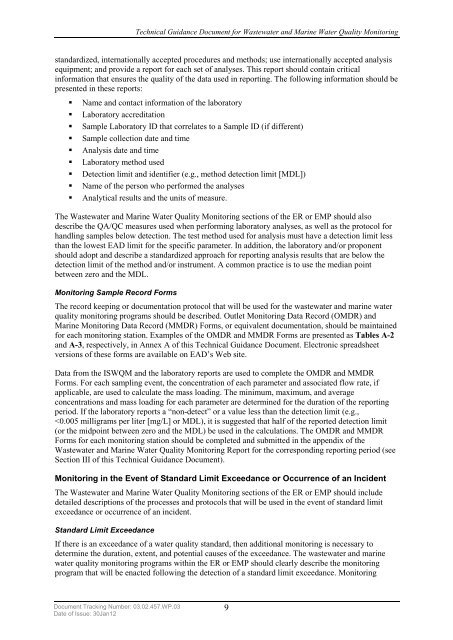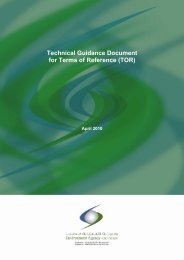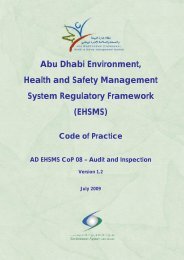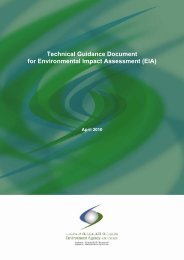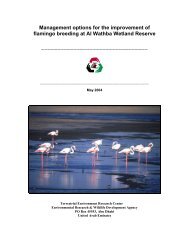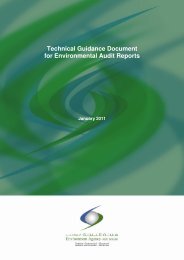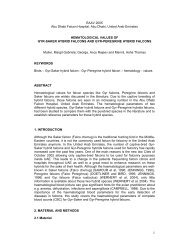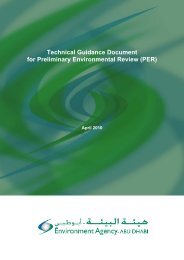<strong>Technical</strong> <strong>Guidance</strong> <strong>Document</strong> <strong>for</strong> <strong>Wastewater</strong> <strong>and</strong> <strong>Marine</strong> <strong>Water</strong> Quality Monitoringh<strong>and</strong>led in a manner that is st<strong>and</strong>ardized <strong>and</strong> ensures the highest level of analysis precision <strong>and</strong>accuracy. The following documents provide guidance <strong>and</strong> examples of good practices <strong>for</strong> thecollection <strong>and</strong> h<strong>and</strong>ling of representative wastewater <strong>and</strong> marine water quality samples:• ISO 5667-1, <strong>Water</strong> Quality—Sampling, Part 1: <strong>Guidance</strong> on the Design of SamplingPrograms <strong>and</strong> Sampling Techniques (ISO, 2006)• ISO 5667-2, <strong>Water</strong> Quality—Sampling, Part 2: <strong>Guidance</strong> on Sampling Techniques (ISO,1991)• ISO 5667-3, <strong>Water</strong> Quality—Sampling, Part 3: <strong>Guidance</strong> on the Preservation <strong>and</strong> H<strong>and</strong>lingof Samples (ISO, 2003)• St<strong>and</strong>ard Methods <strong>for</strong> the Examination of <strong>Water</strong> <strong>and</strong> <strong>Wastewater</strong> (APHA, 1998).An EAD–approved <strong>and</strong> –registered environmental consultant operating within Abu Dhabi Emirate oremployees of the proposed project can collect the wastewater <strong>and</strong> marine water quality samples. Inboth cases, EAD must approve the sample collection protocol detailed within the ER or EMP. Inaddition, the person or company collecting the in situ measurements must strictly adhere to thisprotocol. A chain-of-custody document should also accompany the samples from the time ofcollection to delivery at the laboratory <strong>for</strong> analysis. The chain of custody should include the followingin<strong>for</strong>mation:• Name of the facility• Name of the person who collected the samples, along with full contact in<strong>for</strong>mation (i.e.,name, affiliation, address, phone number, fax number, e-mail address, <strong>and</strong> Web site)• Sample type (e.g., composite or grab)• Container type <strong>and</strong> number• Name of laboratory that conducted the analyses• Unique Laboratory ID that correlates to the Sample ID• Required analyses• Preservative• Method of delivery• Laboratory delivery date <strong>and</strong> time• The name of the person who relinquished the sample <strong>and</strong> the date <strong>and</strong> time• The name of the person who received the sample <strong>and</strong> the date <strong>and</strong> time• Any special instructions.Sample AnalysisDetails should be provided regarding the protocol, methods, analysis laboratory, <strong>and</strong> quality assurance<strong>and</strong> quality control (QA/QC) measures that will be adopted <strong>for</strong> sample analysis associated with thewastewater <strong>and</strong> marine water quality monitoring programs. Sample analysis should follow a st<strong>and</strong>ardprotocol <strong>and</strong> be per<strong>for</strong>med using methods that are accurate, repeatable, <strong>and</strong> considered to be goodinternational practice. The following documents outline good practices, QA/QC protocols, <strong>and</strong>approved st<strong>and</strong>ard methods of analysis used <strong>for</strong> water quality monitoring:• The U.S. Code of Federal Regulations, Title 40—Protection of Environment, Chapter 1,U.S. Environmental Protection Agency, Sub-chapter D, <strong>Water</strong> Programs Part 136—<strong>Guidance</strong><strong>for</strong> Establishing Test Procedures <strong>for</strong> the Analysis of Pollutants• Methods <strong>for</strong> the Examination of <strong>Water</strong>s <strong>and</strong> Associated Materials (The Environment Agency,2009b)• St<strong>and</strong>ard Methods <strong>for</strong> the Examination of <strong>Water</strong> <strong>and</strong> <strong>Wastewater</strong> (20 th edition) (APHA,1998).The laboratory conducting the sample analyses <strong>for</strong> the wastewater <strong>and</strong> marine water qualitymonitoring programs should be an EAD–registered laboratory. This laboratory should follow<strong>Document</strong> Tracking Number: 03.02.457.WP.03Date of Issue: 30Jan128
<strong>Technical</strong> <strong>Guidance</strong> <strong>Document</strong> <strong>for</strong> <strong>Wastewater</strong> <strong>and</strong> <strong>Marine</strong> <strong>Water</strong> Quality Monitoringst<strong>and</strong>ardized, internationally accepted procedures <strong>and</strong> methods; use internationally accepted analysisequipment; <strong>and</strong> provide a report <strong>for</strong> each set of analyses. This report should contain criticalin<strong>for</strong>mation that ensures the quality of the data used in reporting. The following in<strong>for</strong>mation should bepresented in these reports:• Name <strong>and</strong> contact in<strong>for</strong>mation of the laboratory• Laboratory accreditation• Sample Laboratory ID that correlates to a Sample ID (if different)• Sample collection date <strong>and</strong> time• Analysis date <strong>and</strong> time• Laboratory method used• Detection limit <strong>and</strong> identifier (e.g., method detection limit [MDL])• Name of the person who per<strong>for</strong>med the analyses• Analytical results <strong>and</strong> the units of measure.The <strong>Wastewater</strong> <strong>and</strong> <strong>Marine</strong> <strong>Water</strong> Quality Monitoring sections of the ER or EMP should alsodescribe the QA/QC measures used when per<strong>for</strong>ming laboratory analyses, as well as the protocol <strong>for</strong>h<strong>and</strong>ling samples below detection. The test method used <strong>for</strong> analysis must have a detection limit lessthan the lowest EAD limit <strong>for</strong> the specific parameter. In addition, the laboratory <strong>and</strong>/or proponentshould adopt <strong>and</strong> describe a st<strong>and</strong>ardized approach <strong>for</strong> reporting analysis results that are below thedetection limit of the method <strong>and</strong>/or instrument. A common practice is to use the median pointbetween zero <strong>and</strong> the MDL.Monitoring Sample Record FormsThe record keeping or documentation protocol that will be used <strong>for</strong> the wastewater <strong>and</strong> marine waterquality monitoring programs should be described. Outlet Monitoring Data Record (OMDR) <strong>and</strong><strong>Marine</strong> Monitoring Data Record (MMDR) Forms, or equivalent documentation, should be maintained<strong>for</strong> each monitoring station. Examples of the OMDR <strong>and</strong> MMDR Forms are presented as Tables A-2<strong>and</strong> A-3, respectively, in Annex A of this <strong>Technical</strong> <strong>Guidance</strong> <strong>Document</strong>. Electronic spreadsheetversions of these <strong>for</strong>ms are available on EAD’s Web site.Data from the ISWQM <strong>and</strong> the laboratory reports are used to complete the OMDR <strong>and</strong> MMDRForms. For each sampling event, the concentration of each parameter <strong>and</strong> associated flow rate, ifapplicable, are used to calculate the mass loading. The minimum, maximum, <strong>and</strong> averageconcentrations <strong>and</strong> mass loading <strong>for</strong> each parameter are determined <strong>for</strong> the duration of the reportingperiod. If the laboratory reports a “non-detect” or a value less than the detection limit (e.g.,


